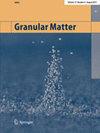Cluster-based particle tracking velocimetry algorithm combining the quasi-parallel correction in granular motions reconstruction
Abstract
Particle Tracking Velocimetry (PTV) is a Lagrange-based flow visualization technique that tracks the motion of multiple particles or granules simultaneously. With the widespread application of three-dimensional (3D) particle imaging systems, 3D PTV algorithms have attracted considerable interest, whereas many 3D algorithms are developed from the corresponding 2D algorithms; moreover, compared with 3D algorithms, 2D algorithms are more suitable for real-time flow monitoring in industry. This paper proposes a 2D PTV algorithm based on the Voronoi diagram (VD) that is optimized by the minimum enclosing ellipse (MEE); then a re-matching process based on a homemade method called Quasi-Parallel Correction (QPC) is developed to correct the abnormal results produced by PTV at large inter-frame particle displacement. This PTV is thereby named MQ-PTV. MQ-PTV is then employed for reconstructing a granular flow made of dense polypropylene particles along a declined chute, an aeolian sand flow over sand bed, the migration of a barchans swarm and the motion of stars, thus confirming its practicability in a wide variety of particle motion reconstruction.


 求助内容:
求助内容: 应助结果提醒方式:
应助结果提醒方式:


